Continuous Glucose Monitor Training Class & My First 3 Days with a CGM
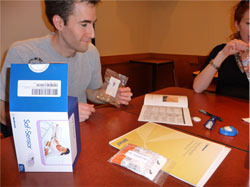
At my continuous glucose monitor class preparing for CGM sensor insertion.
I had originally planned on writing about Friday’s one-on-one continuous glucose monitor training class, but since 3 days have passed since the class, I’m going to also focus on the slightly unsteady relationship that I’ve had thus far with the CGM component of my MiniMed Paradigm Revel Insulin Pump and Continuous Glucose Monitoring System (it’s a mouthful, I know).
To sum up Friday afternoon’s continuous glucose monitor class, which I’ve documented with the pictures you see in this post, it went very well. Ellen, my insulin pump and continuous glucose monitor instructor from Medtronic, did another good job explaining the device and showing me how to properly use the CGM component. She answered all of the questions and concerns that my wife and I had, including those regarding the initial settings of the high and low sensor glucose alerts, predictive alerts, etc. It was at this time that the most shocking moment of the class occurred.
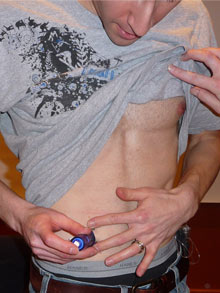
Using the Sen-serter insertion device to insert the CGM sensor under my skin.
Ellen, the Medtronic instructor, informed us that my endocrinologist had recommended that the low sensor alert be set at 50. FIFTY! At that moment, I looked at my wife whose face had quickly become pale and frozen. It was as if the blood in her body had momentarily left to retrieve a match so that it could bring itself to a boil if necessary. Much to our relief, we quickly realized that Ellen seemed just as surprised. She agreed that setting the low alert at 80 mg/dl would be a better starting point. My doctor’s recommendation left my wife and I significantly doubting her knowledge of continuous glucose monitoring, especially given the varying lag between the CGM’s sensor glucose readings and traditional finger-stick blood glucose readings. Our doubt was reinforced in the days that followed when we noticed that the lag between sensor glucose and blood glucose readings seems to widen even more when levels are falling quickly.
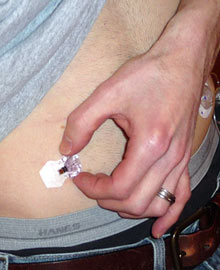
Holding the sensor base after having just removed the introducer needle.
So far, my new relationship with my continuous glucose monitor has been a bit bumpy. It’s kind of like starting to date someone who you’ve just met; you don’t know exactly where they’re coming from or to what degree you can trust them. However, you soon get to know them and you begin to learn all the subtle personality traits that make them who they are, for better or worse. I just hope that the CGM turns out to be a reliable companion, despite our slightly rocky start.
Last night, my CGM and I had our first fight. Having over-bolused for dinner (I shot too much for a pear that I thought had more carbs than it did), combined with the fact that the late evening hours are when my blood sugar levels are the most sensitive, I found myself dropping quickly. My wife Trisha asked me to test with a finger-stick after an hour had passed since dinner, fearing that I over-shot. My BS was 89 but when we looked at my continuous glucose monitor’s sensor glucose reading, it was reading around 134, which is almost a 50 mg/dl difference. I realize that the CGM’s SG (sensor glucose) reading usually lags behind the
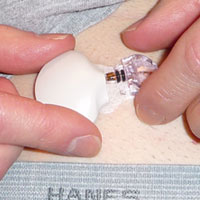
Connecting the continuous glucose monitor transmitter to the sensor.
What have I learned? That when the CGM manuals and the instructor for the continuous glucose monitor training class all emphasized that the CGM is more about trends and direction than actual numbers, they weren’t kidding. My
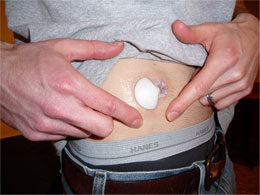
CGM sensor with the transmitter attached.





 My name is Kevin Lang and I am a Type 1 Diabetic who was diagnosed in May of 2004 at the age of 27. My last A1C was 6.0 in May 2015. I used to use daily shots of Lantus and Novolog to control my blood sugar until I switched to the MiniMed Paradigm Revel Insulin Pump in February 2011. To learn more about me, follow the about link in the menu bar.
My name is Kevin Lang and I am a Type 1 Diabetic who was diagnosed in May of 2004 at the age of 27. My last A1C was 6.0 in May 2015. I used to use daily shots of Lantus and Novolog to control my blood sugar until I switched to the MiniMed Paradigm Revel Insulin Pump in February 2011. To learn more about me, follow the about link in the menu bar.
We are in the process of getting a pump with the cgm for our son (9) and after reading your story it gives us an idea on how this might work or not work. Like you mentioned we will have to learn how this will work for us and what the lag will be. Thank you for putting this out so we don’t get so fustrated and give this a chance.
Betsy, best of luck to you and your son with the CGM. If I can offer any additional advice at this point, it would be to make sure to calibrate the CGM when your son’s levels are steady. If you do it when he’s rising or falling too quickly, then it can cause the CGM to become out of whack. Also, don’t get discouraged, it can be a huge help, not only with regard to safety in terms of preventing lows and highs, but also with regard to showing you how his blood sugar is reacting to what he is eating.